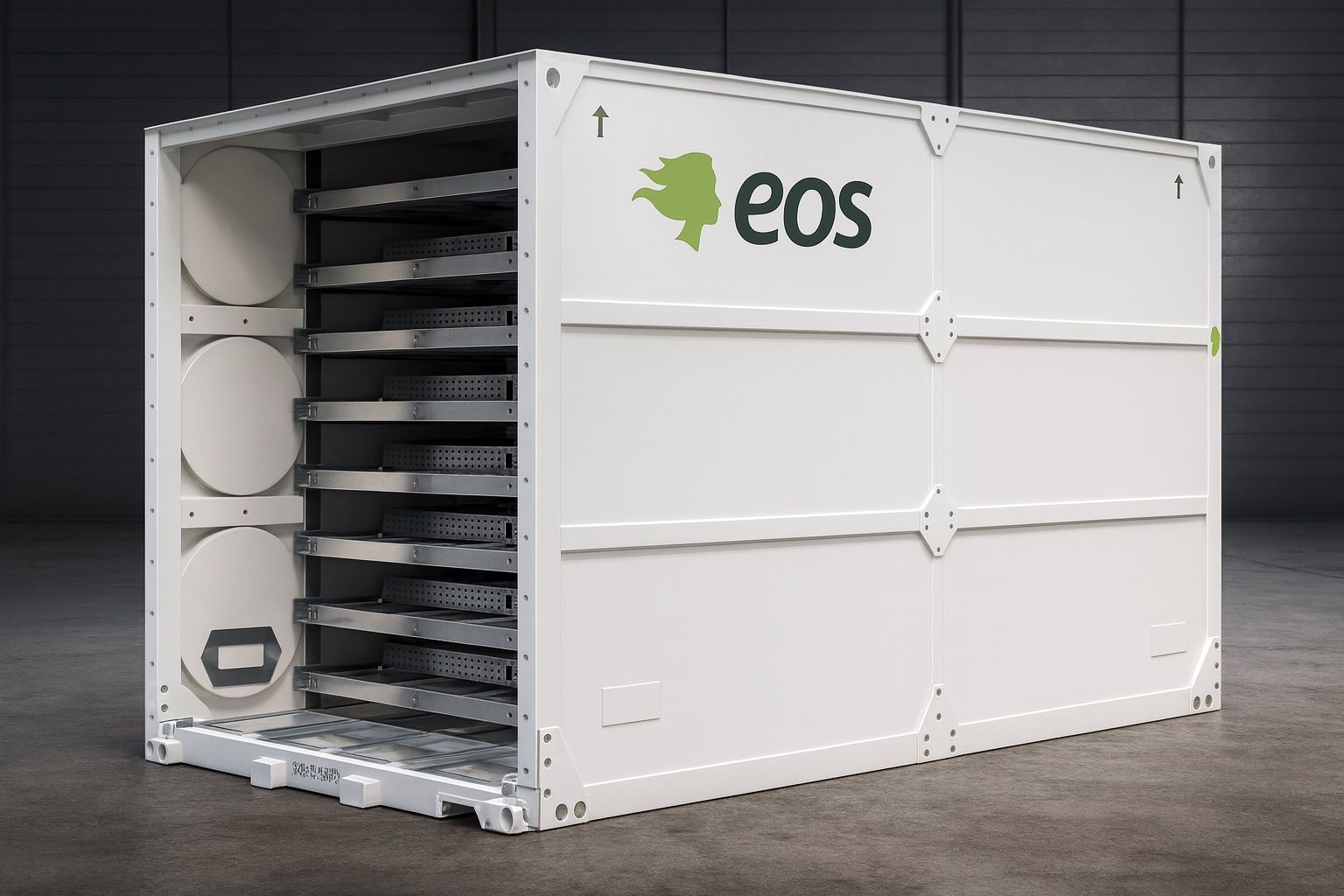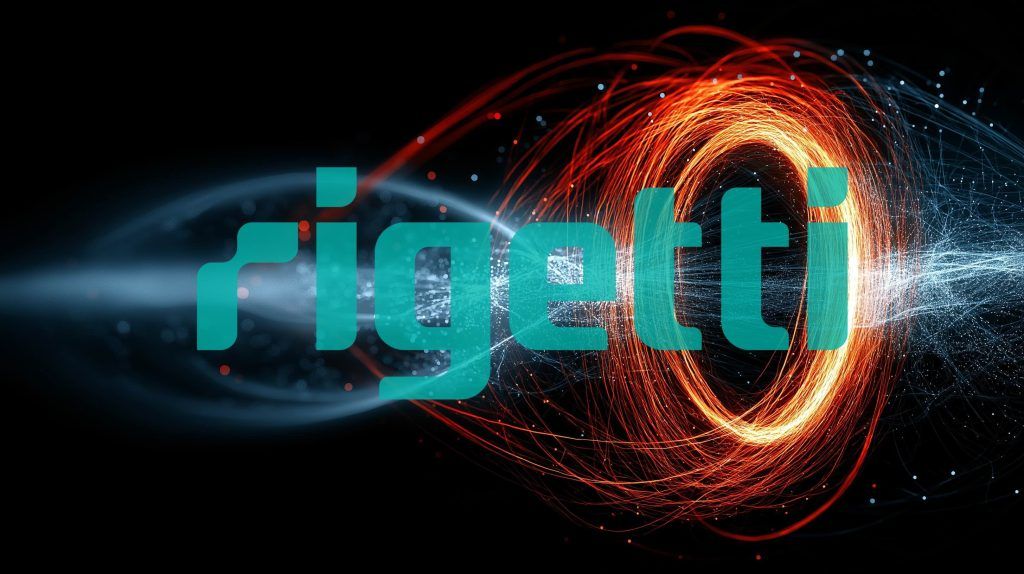Key Facts October 21, 2025
- Stock Surge: Eos Energy Enterprises (NASDAQ: EOSE) shares jumped sharply on Tuesday, rising as much as 14–20% intraday on heavy trading after a flurry of positive news [1] [2]. By mid-day, EOSE was up around 10% at ~$16 per share [3] – extending a remarkable October rally that saw the stock hit new 52-week highs last week [4].
- Big Battery Deals: The company announced a strategic collaboration with Talen Energy to develop energy storage for Pennsylvania’s booming AI data centers – including plans for a $75 million battery factory that will double Eos’s production capacity in the Pittsburgh region by mid-2026 [5]. Eos also unveiled a supply agreement with renewables firm MN8 Energy for up to 750 MWh of its U.S.-made long-duration battery systems [6], aimed at providing 10-hour clean power for large commercial projects.
- Expansion Backed by Pennsylvania: Governor Josh Shapiro’s administration awarded Eos a $24 million state support package under “Project AMAZE” to fuel the company’s U.S. manufacturing expansion [7]. Eos will build a new 432,000 sq. ft. facility in Pennsylvania to reach 8 GWh of annual battery output, and establish a software technology hub in Pittsburgh – moves that will add around 1,000 jobs and make the state a growing hub for energy storage innovation [8] [9].
- Analyst Reactions: Wall Street’s response is mixed. Stifel more than doubled Eos’s price target to $22 (from $10) on October 15, citing surging demand from AI and data center customers [10]. However, most analysts remain cautious – the average 12-month target is only ~$8 [11], far below the current price. Many brokers rate EOSE a Hold, pointing to the company’s lack of profits and recent dilution (Eos filed to sell ~7.3 million new shares this month) [12].
- Booming Market, But Execution Key: Investors are betting on Eos as a play on the long-duration energy storage boom. U.S. utility-scale battery installations are projected to jump ~50% this year amid record power demand from AI data centers and renewables [13]. Eos’s zinc-based battery tech, made in America, stands to benefit from hefty federal incentives favoring domestic storage solutions [14]. Company leaders reaffirmed 2025 revenue guidance of $150–$190 million and aim to break even on gross margins by early 2026 [15]. Still, Eos must execute on its $12+ billion project pipeline and improve finances to justify its lofty valuation – a point even bulls and insiders acknowledge [16] [17].
EOSE Stock Soars on Fresh Catalysts
Eos Energy Enterprises stock surged on Tuesday, October 21, after the company rolled out several major announcements that electrified investor sentiment. The battery maker’s shares spiked as high as 14%–20% above the prior day’s close on the news [18] [19]. As of mid-day, EOSE was holding a ~10% gain around $16 per share [20] – up dramatically from the ~$7–8 range of late September. This continues a stunning run: Eos’s stock has now skyrocketed over 100% in the past few weeks and roughly 200% year-to-date, vastly outperforming the broader market [21] [22].
Tuesday’s jump builds on momentum from earlier in October. Just last week, EOSE hit a new 52-week high around $17.36 after a single-day 20% rally [23]. That spike was fueled by a blockbuster JPMorgan initiative – announced October 13 – to invest $1.5 trillion in strategic U.S. industries like clean energy and grid infrastructure. Investors “gobbled up” battery and renewable energy stocks on hopes of new funding, helping Eos soar to those highs [24] [25]. “Thanks to today’s rally, Eos Energy is now up almost 48% in October alone and 144% since Sept. 1,” The Motley Fool noted last week [26]. Such rapid gains and high trading volumes (EOSE traded 35 million shares on Oct. 13 vs. ~16M average [27]) indicate intense speculative interest, as well as potential volatility ahead.
Market experts say the excitement around Eos reflects a broader “gold rush” for energy storage plays. The stock’s beta of ~2.2 and short interest near 30% suggest that while many traders are bullish, others are betting on a pullback [28]. Indeed, EOSE saw a brief dip mid-month (–12% on Oct. 16) amid profit-taking and news of a planned share offering, before resuming its climb [29]. The stage was set for another leap upward on Oct. 21 as Eos unveiled concrete deals and expansion plans confirming that its business momentum is catching up with the stock’s hype.
New Deals Target AI Data Centers and Grid Demand
The headline catalyst for Eos’s latest surge was its strategic collaboration with Talen Energy – a major independent power producer – to develop long-duration battery storage projects across Pennsylvania. Announced early Tuesday, the partnership centers on powering the state’s fast-growing network of artificial intelligence (AI) and cloud computing data centers [30] [31]. These facilities require enormous, round-the-clock electricity, and Pennsylvania officials have warned of a potential power capacity crunch as AI demand soars. By pairing Eos’s innovative batteries with Talen’s generation assets (including at retired coal plant sites ripe for repurposing), the two companies aim to boost grid reliability and “unlock greater capacity” from existing infrastructure [32] [33].
A key element of the deal is Eos’s plan to build a new battery manufacturing plant dedicated to serving projects for Talen and others. The company will invest $75 million in a state-of-the-art factory in western Pennsylvania, slated to come online by mid-2026 [34]. According to CEO Joe Mastrangelo, this facility will double Eos’s production capacity in the Pittsburgh area to about 2 GWh (gigawatt-hours) of batteries per year [35] – enough to supply roughly 1.5 million homes for an hour of backup power [36]. In effect, Eos is scaling up to meet Talen’s needs: under the collaboration, the companies envision developing “multiple gigawatt-hours” of energy storage at or near Talen’s power plants across Pennsylvania [37]. “By pairing Talen’s operational expertise and infrastructure with Eos’s safe, scalable zinc-based storage technology, we’re strengthening grid resiliency and powering the next generation of digital infrastructure with urgency,” said Mastrangelo in the announcement [38]. Talen’s CEO Mac McFarland added that long-duration, Pennsylvania-made batteries will help support data centers and communities with reliable, low-carbon energy [39].
Separately on Tuesday, Eos revealed another major contract: a supply agreement with MN8 Energy, a leading renewable energy and storage developer. MN8 plans to deploy up to 750 MWh (megawatt-hours) of Eos’s Z3™ zinc battery systems across multiple projects [40]. The initial phase will pair 200 MWh of Eos batteries with large solar farms, providing around 10 hours of energy storage – essentially enabling solar power to run consistently through the night [41]. Unlike conventional lithium-ion batteries, Eos’s zinc-based technology is non-flammable and optimized for 3–12 hour discharge durations, making it attractive for such long-duty applications [42]. The companies did not disclose the deal’s dollar value, but analysts call 750 MWh a “huge” volume – roughly enough battery capacity to supply a mid-sized city for 10 hours. News of this MN8 partnership further validates Eos’s order book and “could catalyze further investment in long-duration storage,” industry observers said [43]. With power grids and data-center operators seeking reliable clean energy around the clock, “we can create efficiency when those [projects] are co-located,” noted Eran Mahrer of Leeward Renewable Energy, pointing to the trend of integrating solar farms with big batteries [44].
Project AMAZE: Pennsylvania Backs Massive Expansion
Underscoring the importance of Eos’s technology to the region, Pennsylvania’s state government is heavily supporting the company’s expansion. Alongside the Talen collaboration, Eos announced the next phase of its growth strategy – nicknamed “Project AMAZE” – in partnership with Governor Josh Shapiro and local authorities [45]. The Commonwealth has awarded Eos a combined $24 million economic development package (grants, tax credits and other incentives) to help fund the new manufacturing facility and a new engineering hub [46]. In return, Eos is committing to create 1,000 high-quality jobs as it scales up production of its Made-in-USA batteries [47].
According to the company, the upcoming 432,000 sq. ft. factory in Marshall Township, PA will operate alongside Eos’s existing plant in Turtle Creek, with a goal of reaching 8 GWh per year of aggregate capacity – enough to produce thousands of battery units annually [48]. The site will transition Eos from “single-piece flow” assembly to high-volume, automated manufacturing, which should drive down unit costs [49]. “Energy storage is the backbone of a modern energy system, and this milestone marks our progress to bring America’s battery to scale,” CEO Mastrangelo said, thanking state leaders for their support [50]. Governor Shapiro cheered the project as a win for local jobs and U.S. energy security, saying “we’re doubling down to aggressively compete for – and win – major projects like this one… I’m proud that Pennsylvania will be home to Eos’s new global headquarters” [51].
In addition to manufacturing, Eos is investing in software and R&D. The company will establish a new software development center at Pittsburgh’s Nova Place technology campus, where its teams will advance the DawnOS™ analytics and controls platform that manages Eos batteries [52]. By deepening ties with Carnegie Mellon University and Pittsburgh’s tech community, Eos aims to attract top talent in robotics, AI, and engineering to improve its systems [53]. Executives say this integrated approach – world-class production together with cutting-edge software – will help Eos enhance its battery performance and support customers as deployments scale up [54] [55]. All told, Project AMAZE represents a significant long-term investment in Eos’s home base of Pennsylvania, which has a rich manufacturing heritage. “We’re proving that in Pittsburgh you can build products in America and grow emerging industries,” said Pranesh Rao, Eos’s SVP of Engineering, calling the new hub a “catalyst to propel Eos to the next level.” [56]
Analysts See Promise – and Risks – in Eos’s Rise
Financial analysts and market experts have been quick to weigh in on Eos Energy’s rapid ascent. The consensus is that demand fundamentals are turning in Eos’s favor, thanks to macro trends like AI, renewable energy growth, and supportive policy. Wood Mackenzie projects U.S. utility-scale energy storage deployments will reach 16.2 GW in 2025 – a 49% jump over 2024 – as developers rush to install batteries that can capture lucrative Investment Tax Credits before deadlines [57]. The power consumption of data centers (especially those training AI) is surging, with one analysis forecasting $2.9 trillion in global data-center spending by 2028, much of that going into power infrastructure [58]. This backdrop creates a “boom” environment for companies like Eos that offer scalable solutions for round-the-clock clean energy. “Soaring demand from data centers… highlights a gap in fully renewable setups, making long-duration storage crucial,” Reuters noted from a recent industry report [59].
Critically, Eos’s U.S.-made technology may give it a competitive edge. Under the Biden administration’s Inflation Reduction Act (IRA) and related trade rules, energy projects earn extra tax credits for using domestically manufactured equipment – ramping up to 55–75% U.S. content required in coming years [60]. “This is a strategic advantage,” says CEO Mastrangelo, noting Eos’s batteries are 100% made in Pennsylvania with ~90% U.S.-sourced components [61]. Allison Weis of Wood Mackenzie agrees that new incentives “should make American batteries more competitive than imports” [62]. The IRA also directly benefits Eos via a generous $45 per kWh production tax credit (45X) for domestic battery cells – roughly $90 million in tax credits per 2 GWh produced [63]. On top of that, Eos secured a $277 million Department of Energy loan to expand its manufacturing, with $68 million already drawn [64]. These tailwinds have not gone unnoticed by investors. “The combination of Biden-era credits and new ‘Made in USA’ rules should make Eos’s zinc batteries an increasingly attractive alternative,” commented Robert Greskowiak, Chief Commercial Officer at Lightshift Energy [65].
Yet for all the optimism, many analysts urge caution given the company’s financial profile. Eos is not yet profitable – in fact, net losses have been mounting as it scales up production [66]. Revenues, while growing fast, are still small relative to its market cap; Eos recorded $15.2 million in revenue for Q2 2025, a quarterly record but essentially the same as its full-year 2024 sales [67]. (The company reaffirmed that it expects $150–$190 million in revenue for full-year 2025, which would be an >10× jump year-over-year if achieved [68].) TechStock² reports that Eos’s order pipeline has swelled to about 77 GWh (>$19 billion worth) of potential projects, including formal backlog and near-term opportunities [69]. This suggests years of demand are lining up – but converting that pipeline into actual deployed, revenue-generating systems is the real test. The company’s execution will need to be flawless to meet its targets, and it will require substantial capital to fulfill large orders. Eos already raised $186 million in the first half of 2025 (including an $81 M equity offering) [70]. And just recently – perhaps to capitalize on the stock’s strength – Eos filed to issue 7.33 million new shares (around 5% of its float) to raise additional funds [71]. Such dilution is common for early-stage cleantech firms, but it tempers upside for existing shareholders. Notably, company insiders have even been selling some shares into the rally, which analysts say could indicate insiders feel the valuation is running hot [72].
Wall Street’s current ratings on EOSE reflect these cross-currents. Most brokers rate the stock a “Hold”, and the average 12-month price target is about $7–8 – roughly 50% below the latest trading price [73] [74]. In other words, despite Eos’s string of wins, many analysts feel the stock has gotten ahead of itself. Simply Wall St cautioned that Eos’s market capitalization (>$4 billion) now prices in a lot of future success, noting the company still trades at “hundreds” of times its current sales and carries a high debt load [75]. On the bullish side, a few analysts have dramatically upgraded their outlook as Eos’s prospects improve. Stifel analyst Stephen Gengaro, for example, hiked his price target from $10 to $22 on October 15 and maintained a Buy rating [76]. Gengaro believes booming data-center power needs and the Talen deal could be a “game-changer” that accelerates Eos’s revenue growth (Stifel’s new target implies significant upside from current levels). Likewise, B. Riley Securities raised its target from $5 to $8 in late September (albeit with a Neutral rating) [77], and Guggenheim initiated coverage with a positive view on Eos’s technology [78]. These disparate targets – from $6 on the low end to $22 on the high end [79] – underscore the uncertainty around Eos. Bulls see a potentially transformational leader in a burgeoning sector, while bears flag the execution risks and Eos’s limited track record in volume production.
Short-Term and Medium-Term Outlook
Looking ahead, Eos Energy’s trajectory will likely be volatile in the short term, analysts say. After an almost parabolic run-up, the stock could see bouts of profit-taking or pullbacks – especially if broader market sentiment shifts. Some technical indicators already show EOSE as “overbought” (its Relative Strength Index recently topped 80) and the stock is trading far above its long-term moving averages [80]. Any hiccup – such as delays in project timelines, cost overruns at the new factory, or a wider tech-market dip – could trigger a sharp correction given the high concentration of momentum traders in the name. Additionally, the planned share issuance and any future capital raises may weigh on the stock price in the near term, as new shares increase supply [81]. “High-growth cleantech companies often face a reality check in the form of dilution,” one commentator noted, suggesting Eos will need to strike a balance between aggressive growth and shareholder dilution.
In the medium term, however, many market watchers argue that Eos Energy’s fundamental story is compelling. The company expects to reach gross margin break-even by early 2026 as economies of scale kick in [82]. If Eos can successfully ramp its 8 GWh Pennsylvania production and fulfill big contracts like the Talen and MN8 deals, revenues should climb exponentially – potentially supporting a higher stock valuation. Eos’s management emphasizes that demand is not the problem: customers are lining up, drawn by the promise of a safe, non-flammable battery solution that’s free from the supply chain issues plaguing lithium-ion. “Hyperscale customers are coming because of our American supply chain,” CEO Mastrangelo said, noting that many large utilities and data-center operators prefer a domestically sourced battery option [83] [84]. The project pipeline of ~$12–19 billion that Eos cites is evidence of robust interest [85]. Under the IRA incentives alone, over $12.9 billion of proposals flowed in since 2023 for Eos’s systems [86]. Converting those proposals into booked revenue will be the company’s main focus over the next 1–2 years.
Analysts say a few milestones will be key to watch: Eos’s quarterly results (to see if revenue is scaling as guided), updates on the DOE loan drawdown and factory build-out, and any further strategic partnerships or large orders. The Talen collaboration, for instance, could expand beyond Pennsylvania if successful, and other utilities may follow suit in leveraging Eos’s technology for grid capacity projects. Competition is another factor – Eos is one of several players in the emergent long-duration battery space (others are developing flow batteries, metal-air batteries, etc.). For now, Eos’s first-mover advantage in zinc-based storage, along with strong policy support, puts it in a favorable position [87] [88].
In summary, Eos Energy Enterprises has rapidly evolved from a niche battery startup into a stock market star riding the clean energy wave. The AI revolution and clean power transition are creating the kind of opportunity that comes along only rarely, and Eos has positioned itself at the nexus of these trends. The company is executing an ambitious growth strategy – new factories, big-name partners, and technological innovation – to seize that opportunity. For investors, EOSE remains a high-risk, high-reward story. The next few quarters will be crucial in determining whether this stock’s astounding run is the start of something even bigger or a “boom” that gets tempered by the realities of scaling up. As one analyst put it, “Eos has the right product at the right time… Now they have to deliver.” All eyes will be on Eos to see if it can convert today’s pipeline and promises into sustainable profits – and potentially power a new era of clean energy growth in the process.
Sources: Official company press releases [89] [90]; Bloomberg [91]; TechStock² (TS2) analysis [92] [93]; Reuters and Yahoo Finance reports [94] [95]; The Motley Fool [96]; Benzinga market data [97]; GuruFocus/MarketBeat [98]; Pennsylvania Governor’s Office statements [99]. All information is up to date as of October 21, 2025.
References
1. www.bloomberg.com, 2. seekingalpha.com, 3. www.benzinga.com, 4. www.sharewise.com, 5. www.bloomberg.com, 6. ts2.tech, 7. www.globenewswire.com, 8. www.globenewswire.com, 9. www.globenewswire.com, 10. markets.financialcontent.com, 11. www.benzinga.com, 12. ts2.tech, 13. ts2.tech, 14. ts2.tech, 15. ts2.tech, 16. ts2.tech, 17. ts2.tech, 18. www.bloomberg.com, 19. seekingalpha.com, 20. www.benzinga.com, 21. ts2.tech, 22. ts2.tech, 23. www.sharewise.com, 24. www.sharewise.com, 25. www.reuters.com, 26. www.sharewise.com, 27. ts2.tech, 28. ts2.tech, 29. ts2.tech, 30. www.globenewswire.com, 31. www.globenewswire.com, 32. www.globenewswire.com, 33. www.globenewswire.com, 34. www.bloomberg.com, 35. www.bloomberg.com, 36. www.bloomberg.com, 37. www.globenewswire.com, 38. www.globenewswire.com, 39. www.globenewswire.com, 40. ts2.tech, 41. ts2.tech, 42. ts2.tech, 43. ts2.tech, 44. ts2.tech, 45. www.globenewswire.com, 46. www.globenewswire.com, 47. www.globenewswire.com, 48. www.globenewswire.com, 49. www.globenewswire.com, 50. www.globenewswire.com, 51. www.globenewswire.com, 52. www.globenewswire.com, 53. www.globenewswire.com, 54. www.globenewswire.com, 55. www.globenewswire.com, 56. www.globenewswire.com, 57. ts2.tech, 58. ts2.tech, 59. ts2.tech, 60. ts2.tech, 61. ts2.tech, 62. ts2.tech, 63. ts2.tech, 64. ts2.tech, 65. ts2.tech, 66. ts2.tech, 67. ts2.tech, 68. ts2.tech, 69. ts2.tech, 70. ts2.tech, 71. ts2.tech, 72. ts2.tech, 73. ts2.tech, 74. www.benzinga.com, 75. ts2.tech, 76. markets.financialcontent.com, 77. www.benzinga.com, 78. markets.financialcontent.com, 79. www.benzinga.com, 80. ts2.tech, 81. ts2.tech, 82. ts2.tech, 83. ts2.tech, 84. ts2.tech, 85. ts2.tech, 86. ts2.tech, 87. markets.financialcontent.com, 88. markets.financialcontent.com, 89. www.globenewswire.com, 90. www.globenewswire.com, 91. www.bloomberg.com, 92. ts2.tech, 93. ts2.tech, 94. ts2.tech, 95. www.benzinga.com, 96. www.sharewise.com, 97. www.benzinga.com, 98. markets.financialcontent.com, 99. www.globenewswire.com







